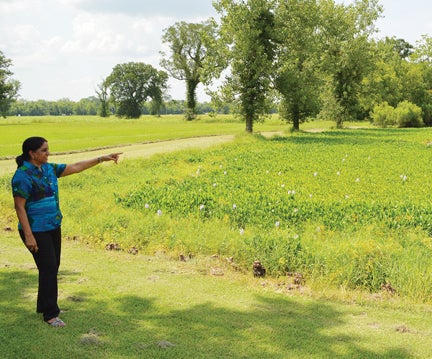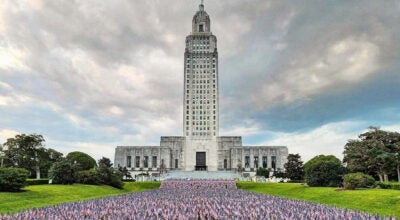Invasive plants clog Belle Terre
Published 11:45 pm Tuesday, July 22, 2014

- Belle Terre Civic Association President Raj Pannu points out in July 2014 where water hyacinths have started taking over the club’s ponds, which started after Hurricane Isaac.
By Monique Roth
L’Observateur
LAPLACE — Invasive plants have taken over the ponds of Belle Terre Country Club, and residents, the club’s owners and St. John the Baptist Parish administration are all sure of one thing: someone needs to clean the dangerous mess up.
The club is private property, for which maintenance and landscaping would typically fall on the owners. However, the owners of the club are taking the stance the parish should bear some responsibility for the invasive plants and drainage issues of the course.
Belle Terre Civic Association President Raj Pannu said water hyacinths started taking over the club’s ponds after Hurricane Isaac. She said the parish initially agreed to clean out the ponds with the expectation the club would manage the upkeep after the cleanings.
Those cleanings never happened, Pannu said.
Samuel Accardo Jr. of Accardo Law Firm in LaPlace, who is representing Belle Terre LLC, said hydrilla plants in the ponds have also been an issue for the owners and residents since 2012’s Hurricane Isaac pushed water into the parish from Lake Pontchartrain.
According to the Washington State Department of Ecology, water hyacinth is considered the world’s worst aquatic plant. The plant forms thick, floating mats that impede water flow and create good breeding conditions for mosquitoes.
The department said hydrilla also forms dense mats of vegetation that interfere with recreation and destroy fish and wildlife habitat.
The main problem with the invasive plants, Pannu said, is they exacerbate previous drainage issues Belle Terre residents face.
Accardo said the club’s owners, as well as residents who own homes along the course, have noticed drainage issues are worse since Hurricane Isaac.
The solution to ease street and course flooding would be to dredge out the ponds, Pannu said, a measure that would carry an estimated $30,000 price tag for the two ponds located on St. Andrews Boulevard alone.
“It essentially boils down to there’s a consensus among some engineers this is strictly a water flow issue,” Accardo said, adding that according to consulted engineers, upstream and downstream cleaning of the course’s ponds and culverts would help ease the course’s flooding, which is devaluing the course. He said when the course was being developed and houses on the course were being built in the 1980s, the parish did not enforce building and drainage codes, which is now causing major issues for the club and subdivision residents.
In a June 24 email to Pannu, Parish President Natalie Robottom wrote, “the responsibility for cleaning and maintaining the ponds on the golf course rests with the owner.”
Robottom said the Public Works Department and parish engineer have visited the site on numerous occasions “to assess and devise a plan to address drainage issues.”
She wrote catch basins and culverts were cleaned throughout the area and “after discussing and analyzing the ponds and their impact to the drainage system, legal counsel advised that a one-time cleaning of the ponds on holes 8 and 14 would be appropriate.”
She said the offer was refused by the country club, and as a result, no cleaning was completed.
Robottom said the parish did hire a contractor to clean out the drainage canal leading from the golf course to Interstate 10.
Pannu said on top of drainage issues, the ponds’ plants are unsightly to drivers passing by and athletes utilizing the course, and also pose a health issue to residents.
She said the ponds could prove to be dangerous if a child were playing near the pond and fell in, considering it could be nearly impossible to visibly locate where they were.
Accardo said the club is “trying to work out an amicable solution” with the parish, but has not come to an agreement.
He said the club’s owners have tremendous concerns for the residents of the Belle Terre subdivision, as well as for their multi-million dollar investment into the club.




